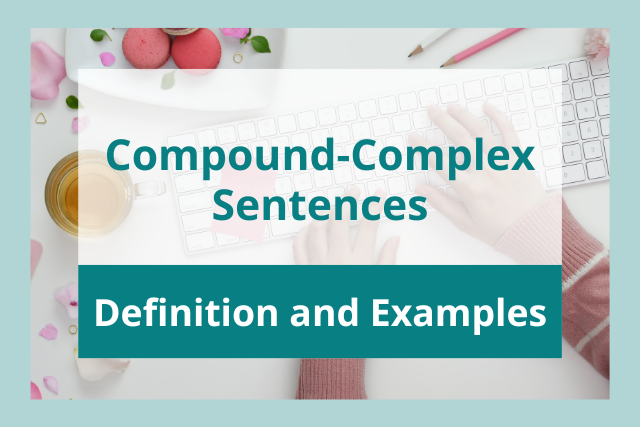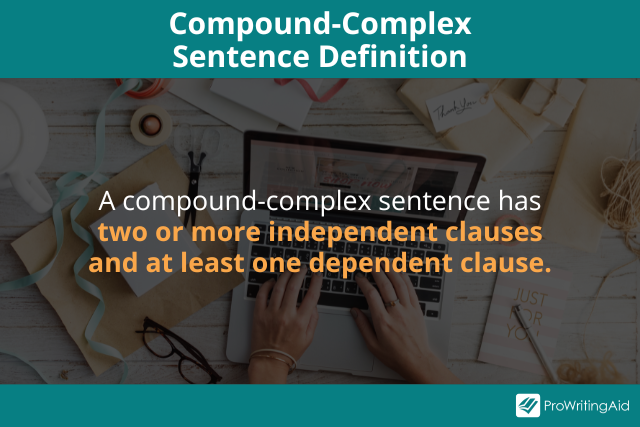
One way to add variety to your writing is to play with sentence structures. The four primary sentence structures are simple, compound, complex, and compound-complex.
Today, we’re looking at compound-complex sentences. These are the most complicated sentence structures, but when done properly, they can improve the flow of your writing.
Read on to learn more about what compound-complex sentences are and how to write them.
What Is a Compound-Complex Sentence?
As the name suggests, a compound-complex sentence comprises a compound and a complex sentence.
A sentence is compound when it has two (or more) independent clauses. A sentence is complex when it combines one independent clause with at least one dependent clause.
As a result, a sentence must have two (or more) independent clauses, and at least one dependent clause to become a compound-complex sentence.

Compound-complex sentences are typically the longest of all sentences. Compound-complex sentences allow you to add a layer of complexity to your writing. They improve the flow and keep your readers engaged. They’re also useful if you’re explaining complicated ideas.
Let’s pull apart a compound-complex sentence to see how they work.
- Though Samantha prefers peanut butter and jelly sandwiches, she ordered a pastrami on rye, and she thought it was delicious.
First, we have our dependent clause: “Though Samantha prefers peanut butter and jelly sandwiches.” Then, there are two independent clauses: “she ordered a pastrami on rye,” and “she thought it was delicious.” In this sentence, the coordinating conjunction "and" joins the two independent clauses.
How to Write a Compound-Complex Sentence
Here are four simple steps for how to write effective compound-complex sentences.
- Choose your independent clauses: You're looking for at least two parts of your sentence that could stand alone as complete sentences. Tip: they should have a verb and a subject. Make sure that the two clauses are related in some way—otherwise they should stay as two separate sentences.
- Choose your dependent clause: Dependent clauses don't express complete thoughts. You couldn't get the full picture of what someone is saying from a dependent clause. Instead, they back up your independent clauses by providing more information.
- Add your conjunctions: These are the glue that hold all of those clauses together. To join your dependent clauses, use subordinating conjunctions like before, as, or although. For joining independent clauses, you'll need a coordinating conjunction, like for, yest, or so.
- Punctuate your sentence properly: If these sentences sound confusing, it's because they are. You'll need perfect punctuation to keep all of the ideas in the right place and to make the sentence easier to understand. The most common error is creating a run-on sentence. This is when you connect your independent clauses with just a comma. Instead, swap your comma for a semi-colon, or add a coordinating conjunction.
Troubleshooting
Comma splices are a common mistake to make when writing compound-complex sentences. Use a grammar checker, such as ProWritingAid, to identify any instances of comma splices, so you can fix them and strengthen your sentences.
Compound-Complex Sentence Structures
The easiest way to understand the structure of a compound-complex sentence is to first understand the structures of compound and complex sentences.
When two or more independent clauses are put together, they create a compound sentence. Independent clauses are complete sentences.
Let’s look at an example of a compound sentence:
- There are some ruins near my house, and I go there sometimes when I need to think.
The sentence above has two independent clauses, “there are some ruins near my house,” and “I go there sometimes when I need to think.”
A coordinating conjunction typically joins the independent clauses in a compound sentence. In the sentence above, the conjunction "and" joins the independent clauses. The other six coordinating conjunctions that can be used are “for,” “or,” “nor,” “but,” “yet,” and “so.”
You can also join compound sentences with a semicolon instead of a coordinating conjunction and a comma. For example, we can write the same sentence above like this:
- There are some ruins near my house; I go there sometimes when I need to think.
To be considered complex, a sentence needs to have an independent clause and one or more dependent clauses. For example:
- There are some ruins near my house, which my cousins and I used to play in when we were younger.
In the sentence above there’s an independent clause, “there are some ruins near my house” and a dependent clause, “which my cousins and I used to play in when we were younger.”
In complex sentences, subordinate conjunctions introduce dependent clauses. In the sentence above, we used “which.” Other subordinate conjunctions include “after,” “although,” “if,” “until,” and “while.”
A compound-complex sentence is like a Frankenstein's monster made up of compound sentence structure and complex sentence structure. it has bits of both sentence types. Here is an example of a compound-complex sentence:
- There are some ruins near my house, which my cousins and I used to play in when we were younger, and I go there sometimes when I need to think.
This sentence includes two independent clauses and one dependent clause.
Let’s break down the sentence to highlight all the relevant sections of the sentence:
- Independent clause 1: There are some ruins near my house
- Subordinating conjunction: which
- Dependent clause: my cousins and I used to play in when we were younger
- Coordinating conjunction: and
- Independent clause 2: I go there sometimes when I need to think.
Compound-Complex Sentence Examples
Compound-complex sentences are very useful in analytical and academic writing for explaining complicated topics. Creative writers can also use them to add interest and engage their readers.
Here are a few more examples of compound-complex sentences:
- He finished his report for work, but he still needs to fill out the accompanying presentation even though he should have had it done last quarter.
- While waiting for the bus, Angela played games on her phone, and Lizzy read a book.
- After all this time, I still can't fathom why he had to make such a big deal of it, but I guess he had his reasons.
- Cameron and Jennifer had only known each other for 3 weeks, but they decided to travel the world together before starting work, and they never regretted the decision.
- As I put the kettle on, I looked in the jar for biscuits, but I couldn't see any in there.
- While Jessica likes rom-coms, Sarah likes thrillers, but Ellie only watches documentaries.
Conclusion on the Compound-Complex Sentence
Remember, your compound-complex sentence needs to have:
- At least two independent clauses
- At least one dependent clause

Now you’re well on your way to using compound-complex sentences in your own writing. Play around with your sentence structures, so your writing doesn’t become monotonous.
Use a variety of sentence types and use ProWritingAid’s sentence structure report to show you where your sentences could use a little more attention.


